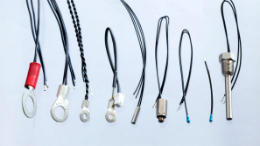5 THERMISTOR SENSOR CONSIDERATIONS WHEN SELECTING AN NTC THERMISTOR
 Selecting a thermistor temperature sensor can be confusing, and you have a lot of options to choose from. You don’t want to risk equipment failure or circuit breaker short-outs. So, how do you make the right selection without sacrificing performance and giving up quality?
Selecting a thermistor temperature sensor can be confusing, and you have a lot of options to choose from. You don’t want to risk equipment failure or circuit breaker short-outs. So, how do you make the right selection without sacrificing performance and giving up quality?
NTC thermistors have been around for many decades and have become the default component for thermistor-based temperature sensing because of their low price point.
Because of their dependence on resistance and temperature, thermistors can be used as temperature sensors or heat sensors. Thermistors are the most sensitive and so are used in precision applications which rely on system adjustments based on even slight temperature changes.
- NTC thermistors come in different sizes and types. Going through with a careful analysis of the application of the thermistor should allow users to narrow down choices, even when lacking other data.
- Thermistors have different electrical properties. The three most common types are current-time, resistance-temperature, and voltage-current characteristics.
- The resistance-temperature curve must be exact for specific applications.
- Some applications demand that the curve is matched or point matched. This is the only way to allow for resistance values at different temperatures.
- Resistance tolerance is also necessary. Ensuring this resistance helps to save on costs while also protecting gear.
Temperature Range
NTC thermistors are well suited to applications from -50° up to +250°C and so are well suited to a range of applications.
Accuracy
NTC thermistors and thermistor probes are the most accurate between -50C and +150°C and if they are glass encapsulated can also be extremely accurate at 250°C.
Ametherm thermistors are produced from carefully selected and tested raw materials. The starting materials are different oxides of metals such as manganese, iron, cobalt, nickel, copper and zinc, to which chemically stabilizing oxides may be added to achieve better reproducibility and stability of the thermistor characteristics.
1. Temperature Range: When selecting a temperature sensor, the first thing to consider is the temperature range of the application. NTC thermistors perform well under an operating range of -50° to 250°, making them suited for a variety of applications in different industries. Although thermocouples work in many of the same applications as NTC thermistors, they lack accuracy with low temperature applications.
2. Accuracy: NTC thermistors ability to achieve the highest accuracy is within -50° to 150° and up to 250° range for glass encapsulated NTC thermistors.
3. Stability: Stability is important in applications where the goal is long-term operation.Temperature sensors can drift over time depending on materials, packaging, and construction. An epoxy-coated NTC thermistor can change by 0.2° per year while a hermetically sealed NTC thermistor changes by only 0.02° per year. Thermocouples have much lower stability of about 1° to 2° per year.
4. Packaging: Packaging requirements are set by the environment the sensor will be used in. NTC thermistors can be customized and potted into various housings dependent on application requirements. They also can be epoxy coated or glass encapsulated for further protection.
5. Noise Immunity: NTC thermistors offer excellent immunity to electrical noise and lead resistance during initial switch-on. While thermocouples are not affected by lead resistance, they are susceptible to electrical noise because they output a small signal that can be affected by electrical noise.